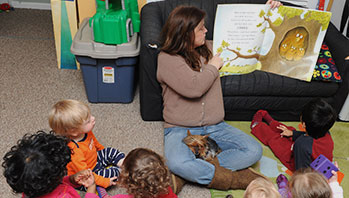- garden
- leaf
- plant
- stem
- vegetable
MA Standards:
Literature/RL.PK.MA.1: With prompting and support, ask and answer questions about a story or a poem read aloud.
Literature/RL.PK.MA.4: With prompting and support, ask and answer questions about unfamiliar words in a story or poem read aloud.
Literature/RL.PK.MA.9: With prompting and support, make connections between a story or poem and one’s own experiences.
Literature/RL.PK.MA.10: Listen actively as an individual and as a member of a group to a variety of age-appropriate literature read aloud.
Head Start Outcomes:
Literacy Knowledge/Book Appreciation and Knowledge: Asks and answers questions and makes comments about print materials.
PreK Learning Guidelines:
English Language Arts/Reading and Literature 6: Listen to a wide variety of age appropriate literature read aloud.
English Language Arts/Reading and Literature 10: Engage actively in read-aloud activities by asking questions, offering ideas, predicting or retelling important parts of a story or informational book.
Read Together: The Ugly Vegetables #2

© Commonwealth of Massachusetts, Department of Early Education and Care (Jennifer Waddell photographer). All rights reserved.
STEM Key Concepts: Many foods that animals, including humans, eat come from plants; We eat certain leaves, roots, fruits, and seeds; Plants exhibit diversity and variation
ELA Focus Skills: Active Listening, Concepts of Print (Identifying Author and Title, Interpreting Illustrations), Letter Recognition. Listening and Speaking, Parts of a Book, Story Comprehension, Vocabulary
Before You Read
Tell children you are going to read The Ugly Vegetables again. Say, Yesterday we read to understand why the little girl thought her mother’s garden was ugly. Today let’s listen for all of the words the little girl uses to describe her mother’s garden and the vegetables that are growing in it.
As You Read
Pause to review words used to describe the ugly vegetables. For example,
- Pause after reading the line “I looked, but saw only black-purple-green vines, fuzzy wrinkled leaves, prickly stems, and a few little yellow flowers.” Ask children, Could you use any of these words describe to describe the plants and vegetables you have been observing this week? Which words would you use? Which plants would you describe?
- Pause after reading “Before long our vegetables grew. Some were big and lumpy.” What do you notice about the plant leaves in the girl’s garden and the leaves in the neighbor’s garden?
- Ask, What do you think the author meant when the girl smelled the “magical aroma” and the neighbors looked like they were “trying to eat the smell”?
After You Read
Discuss the story. Then talk about some of the words the author used to describe the plants in the book. Ask questions such as,
- Why do you think the author chose the word prickly to describe the zucchini’s stem? Have you ever touched a zucchini? Why is that a good word to use to describe the stem? Have you explored any plants that have prickly parts? Which plants?
- Do you think the little girl was happy her Mommy planted “ugly” vegetables in the end? Why do you think that?
- Are any of the plants you have been exploring outdoors or indoors similar to the ones in the little girl’s garden? How are they similar? (color, size, texture, etc.)
Share the glossary and recipe at the back of the book with children. Say, A glossary is the part of a book that tells us what some words mean. Explain that usually these are “special” or unusual words that the author thinks most readers won’t know.
Social Emotional Tip: Reread the section where the neighbors want to trade flowers for some soup. Guide children to understand that to trade means we give someone something and they give us something in return. Ask, Have you ever traded with someone? What did you give? What did you get in return?
Adaptation: If younger children have trouble concentrating as you move through the book, read just a few pages and return later to read more.
